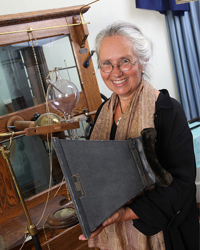Two centuries of the stethoscope − how much longer will it survive?
The History of Medicine Office is excited to announce that Dr. Jacalyn Duffin will be the 2016 guest lecturer at the History of Medicine Visiting Speaker Series. The title of Dr. Duffin’s lecture is, “The Stethoscope at 200: A Revolutionary Device now Obsolete?”
Join us on Tuesday, October 18 from 6:00 - 7:00 p.m. in the Dental Sciences Building, Room 1002. Reception to begin at 5:30 pm. Light refreshments will be served.
 Five Questions with Dr. Jacalyn Duffin, Hannah Chair in the History of Medicine at Queen’s University:
Five Questions with Dr. Jacalyn Duffin, Hannah Chair in the History of Medicine at Queen’s University:
Tell us about the work you will present in your lecture for this year’s Visiting Speaker Series?
The stethoscope was invented in France 200 years ago to serve the discovery of auscultation—the diagnostic practice of listening to the chest. I used the clinical case records, lecture notes and personal letters of the inventor, physician René Laennec (1781-1826), to explore this discovery and his interpretation of the lung and heart sounds. The instrument made it possible to detect anatomical changes before the patient became a cadaver, and it fostered a new way of thinking about all diseases that increased the importance of anatomy and downplayed the subjectivity of symptoms. In a sense, it heralded many other diagnostic tools, such as body chemistry and imaging.
How did you first become interested in this topic?
It was the topic of my dissertation. As a clinician I have always used a stethoscope, but since the completion of my graduate studies and book, To See with a Better Eye (Princeton UP 1998), I continue to watch the evolution of the instrument itself and the more recent statements that it has become obsolete.
Was there anything that surprised you about this project once you got deeper into your research?
As a royalist and a Catholic in post-revolutionary Paris, Laennec was unpopular in his lifetime, often said to be owing to his political and religious differences from the mainstream. In addition, I discovered that he clung to some scientific ideas about the psyche and the soma that were considered to have been outmoded by his own invention. He offered sound clinical evidence for retaining these ideas. I argue that this seemingly backward stance also contributed to his unpopularity and probably explains why the book manuscript that he wanted published posthumously was suppressed.
Tell us a little about yourself. What is your typical workday like as Hannah Chair in the History of Medicine?
I am a haematologist and a historian. Most of the week I spend teaching undergraduates, graduate students and medical students in courses or small groups—and sometimes one-on-one. I am cross-appointed in Philosophy, History, Medicine, Nursing, and Education. I also support independent research projects of students and colleagues at Queen’s and elsewhere. I have been involved with the administration of the school and many curriculum revisions. Until this year, I worked one day a week in the cancer clinic, mostly with breast cancer patients on chemotherapy. I try to spend time on my own research projects, including two active websites, but that work usually falls on nights and weekends.
How did you originally become interested in the History of Medicine?
At the University of Toronto, I was influenced by medical teachers and friends who valued medical history, especially haematologist Dr. Dale A. Dotten and obstetrician Dr. Marjorie Moore.
Nevertheless, I expected to be a full-time clinician and achieved that goal by 1979 when I moved to Thunder Bay. But my husband’s work as a diplomat resulted in us relocating to Paris, France, where I could not practice medicine for legal reasons. I decided to spend my time in Paris doing something that I could not do at home.
Dr. Mirko Grmek, a medicine historian, kindly took me on as a graduate student, and he suggested the topic of the stethoscope because 10,000 pages of Laennec’s manuscripts had just been catalogued but not studied. It was a beautiful topic – just right for me and my clinical past and (lack of) linguistic ability. I got hooked.
When we returned to Canada I wanted to go back to clinical medicine, but no one would have me. I was lucky to hold a Hannah Postdoctoral Fellowship at the University of Ottawa with Hannah Professor Toby Gelfand. This allowed me to begin publishing my dissertation and developing a new project on 19th Century Canada. I also worked hematology locums in Ottawa area hospitals. Three years later, in 1988, I was offered the Hannah Chair at Queen’s where I have been fortunate to use all my training in both disciplines every day for almost thirty years.








